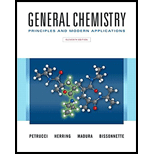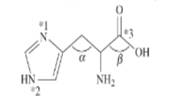
GENERAL CHEMISTRY(LL)-W/MASTERINGCHEM.
11th Edition
ISBN: 9780134566030
Author: Petrucci
Publisher: PEARSON
expand_more
expand_more
format_list_bulleted
Textbook Question
Chapter 11, Problem 65IAE
Histidine, an essential amino acid, serves as a part of the active center in many enzymes. It is the precursor to histamine, a neurotransmitter and a component of the body's immune response. The structure of histidine is shown below.

Identify the hybridization scheme for the atoms marked with an asterisk, and indicate the values of the bond angles marked a and ß.
Expert Solution & Answer
Want to see the full answer?
Check out a sample textbook solution
Students have asked these similar questions
Please answer the question and provide a detailed drawing of the structure. If there will not be a new C – C bond, then the box under the drawing area will be checked.
Will the following reaction make a molecule with a new C – C bond as its major product:
Draw the major organic product or products, if the reaction will work. Be sure you use wedge and dash bonds if necessary, for example to distinguish between major products with different stereochemistry.
Please do not use AI. AI cannot "see" the molecules properly, and it therefore gives the wrong answer while giving incorrect descriptions of the visual images we're looking at. All of these compounds would be produced (I think). In my book, I don't see any rules about yield in this case, like explaining that one product would be present in less yield for this reason or that reason. Please explain why some of these produce less yield than others.
Please answer the question and provide detailed explanations.
Chapter 11 Solutions
GENERAL CHEMISTRY(LL)-W/MASTERINGCHEM.
Ch. 11 - Prob. 1ECh. 11 - Explain why it is necessary to hybridize atomic...Ch. 11 - Describe the molecular geometry of H2O suggested...Ch. 11 - Describe the molecular geometry of NH2 suggested...Ch. 11 - In which of the following, CO32-,SO2,CCl4,CO,NO3-...Ch. 11 - In the manner of Example 11-1, describe the...Ch. 11 - For each of the following species, identify the...Ch. 11 - Propose a plausible Lewis structure, geometric...Ch. 11 - Describe a hybridization scheme for the central Cl...Ch. 11 - Describe a hybridization scheme for the central S...
Ch. 11 - Match each of the following species with one of...Ch. 11 - Propose a hybridization scheme to account for...Ch. 11 - Indicate which of the following molecules and ions...Ch. 11 - In the manner of Figure 11-18, indicate the...Ch. 11 - Write Lewis structures for the following...Ch. 11 - Represent bonding in the carbon dioxide molecule,...Ch. 11 - Use the method of Figure 11-19 to represent...Ch. 11 - Use the method of Figure 11-19 to represent...Ch. 11 - The molecular model below represents citric acid,...Ch. 11 - Malic is e common organic acid found in unripe...Ch. 11 - Shown below are ball-and-stick models. Describe...Ch. 11 - Shown below are ban-and-stick models. Describe...Ch. 11 - Prob. 23ECh. 11 - The structure of the molecule allene, CH2CCH2 , is...Ch. 11 - Angelic acid, shown below, occurs in symbol root,...Ch. 11 - Dimethylolpropionic acid, shown below, is used in...Ch. 11 - Explain the essential difference in how the...Ch. 11 - Describe the bond order of diatomic carbon, C2 ,...Ch. 11 - Prob. 29ECh. 11 - The paramagnetism of gaseous B2 has been...Ch. 11 - Prob. 31ECh. 11 - Is it correct to say that when a diatomic molecule...Ch. 11 - For the following pairs of molecular orbitals,...Ch. 11 - For each of the species C2+,O2,F2+ , and NO+ ; a....Ch. 11 - Write plausible molecular orbital occupancy...Ch. 11 - We have used the term “isoelectronic” to refer to...Ch. 11 - Consider the molecules NO+ and N2+ and use...Ch. 11 - Consider the molecules CO+ and CN- and use...Ch. 11 - Construct the molecular orbital diagram for CF....Ch. 11 - Construct the molecular orbital diagram for SrCl....Ch. 11 - Explain why the concept of delocalized molecular...Ch. 11 - Explain how it is possible to avoid the concept of...Ch. 11 - In which of the following molecules would you...Ch. 11 - In which of the following ions would you expect to...Ch. 11 - The Lewis structure of N2 indicates that the...Ch. 11 - Show that both the valence bond method and...Ch. 11 - A group of spectroscopists believe that they have...Ch. 11 - Lewis theory is satisfactory to explain bonding in...Ch. 11 - The compound potassium sesquoxide has the...Ch. 11 - Draw a Lewis structure for the urea molecule, CO(...Ch. 11 - Methyl nitrate, CH2NO2 , is used as a rocket...Ch. 11 - Fluorine nitrate, FONO2 , is an oxidizing agent...Ch. 11 - Draw a Lewis structure(s) for the nitrite ion, NO2...Ch. 11 - Think of the reaction shown here as involving the...Ch. 11 - Prob. 55IAECh. 11 - Prob. 56IAECh. 11 - The molecule formamide, HCONH2 , has the...Ch. 11 - Pyridine, C2H2N , is used in the synthesis of...Ch. 11 - Prob. 59IAECh. 11 - The ion F2Cl is linear, but the ion F2Cl+ is bent....Ch. 11 - Prob. 61IAECh. 11 - Prob. 62IAECh. 11 - Prob. 63IAECh. 11 - Prob. 64IAECh. 11 - Histidine, an essential amino acid, serves as a...Ch. 11 - The anion I42 is linear, and the anion I5 is...Ch. 11 - Prob. 67IAECh. 11 - A conjugated hydrocarbon has an alternation of...Ch. 11 - An elusive intermediate of atmospheric reactions...Ch. 11 - Resonance energy is the difference in energy...Ch. 11 - Furan, C4H4O , is a substance derivable from oat...Ch. 11 - As discussed in Are You Wondering 11-1, the sp...Ch. 11 - In Chapter 10, we saw that electronegativity...Ch. 11 - Borazine, B2N2H2 is often referred to as inorganic...Ch. 11 - Which of the following combinations of orbitals...Ch. 11 - Prob. 76FPCh. 11 - Prob. 77SAECh. 11 - Prob. 78SAECh. 11 - Explain the important distinctions between the...Ch. 11 - A molecule in which sp2 hybrid orbitals are used...Ch. 11 - Prob. 81SAECh. 11 - The hybridization scheme for the central atom...Ch. 11 - Of the following, the species with a bond order of...Ch. 11 - The hybridization scheme for Xe in XeF2 is (a) sp;...Ch. 11 - Delocalized molecular orbitals are found in (a)...Ch. 11 - Prob. 86SAECh. 11 - Why does the hybridization sp2d not account for...Ch. 11 - What is the total number of (a) bonds and (b) p...Ch. 11 - Which of the following species are paramagnetic?...Ch. 11 - Use the valence molecular orbital configuration to...Ch. 11 - Use the valence molecular orbital configuration to...Ch. 11 - Which of these diatomic molecules do you think has...Ch. 11 - For each of the following ions or molecules,...Ch. 11 - Draw Lewis structures for the NO2 and NO2+ ions,...Ch. 11 - In which of the following is the central atom sp...Ch. 11 - Prob. 96SAECh. 11 - According to molecular orbital theory, the O22 ion...Ch. 11 - What is the angle between the hybrid orbitals...Ch. 11 - Consider the molecule with the Lewis structure...Ch. 11 - Construct a concept map that embodies the ideas of...Ch. 11 - Prob. 101SAECh. 11 - Construct a concept map that describes the...
Knowledge Booster
Learn more about
Need a deep-dive on the concept behind this application? Look no further. Learn more about this topic, chemistry and related others by exploring similar questions and additional content below.Similar questions
- All of these compounds would be produced (I think). In my book, I don't see any rules about yield in this case, like explaining that one product would be present in less yield for this reason or that reason. Please explain why some of these produce less yield than others.arrow_forward5. Fill in the missing molecules in the following reaction pathway. TMSO Heat + CI then HF O₂N (1.0 equiv) AICI 3 OMearrow_forwarde. O₂N NO2 1. excess H2, Pd/C 2. excess NaNO2, HCI 3. excess CuCNarrow_forward
- Help with a periodic table task.' Procedure Part 1: Customizing a Periodic Table Use a textbook or other valid source to determine which elements are metals, nonmetals, metalloids (called semimetals in some texts), alkali metals, alkaline earth metals, transition metals, halogens, and noble gases. Download and print a copy of the Periodic Table of Elements. Use colored pencils, colorful highlighters, or computer drawing tools to devise a schematic for designating each of the following on the periodic table: Group numbers Period number Labels for these groups: alkali metals, alkaline earth metals, transition metals, inner transition metals (lanthanides and actinides), other metals, metalloids (semimetals), other nonmetals, halogens, and noble gases Metals, nonmetals, and metalloids Note: Write the group and period numbers and color/highlight each element for categorization. Be sure to include a key for the schematic. Take a photo of the completed periodic table and upload the…arrow_forwardDon't used hand raiting and don't used Ai solutionarrow_forwardCan you explain these two problems for mearrow_forward
- 个 ^ Blackboard x Organic Chemistry II Lecture (m x Aktiv Learning App x → C app.aktiv.com ← Curved arrows are used to illustrate the flow of electrons. Using the provided starting and product structures, draw the curved electron-pushing arrows for the following reaction or mechanistic step(s). Be sure to account for all bond-breaking and bond-making steps. Problem 28 of 35 :OH H HH KO Select to Edit Arrows CH CH₂OK, CH CH2OH 5+ H :0: Donearrow_forwardCan you explain those two problems for me please.arrow_forwardDo we need to draw the "ethyne" first for this problem? im confusedarrow_forward
- Can you explain how this problem was solved.arrow_forwardQuestion 2 show work. don't Compound give Ai generated solution So (J K-1 mol-1) A 26 B 54 C 39 D 49 At 298 K, AG° is 375 kJ for the reaction 1A + 1B → 4C + 2D Calculate AH° for this reaction in kJ.arrow_forward1. Provide a complete IUPAC name for each of the following compounds. a) b) c) OH OH OH a) b) c) 2. Provide a complete IUPAC name for each of the following compounds. a) b) a) OH b) он c) OB >=arrow_forward
arrow_back_ios
SEE MORE QUESTIONS
arrow_forward_ios
Recommended textbooks for you
 Chemistry: Principles and PracticeChemistryISBN:9780534420123Author:Daniel L. Reger, Scott R. Goode, David W. Ball, Edward MercerPublisher:Cengage Learning
Chemistry: Principles and PracticeChemistryISBN:9780534420123Author:Daniel L. Reger, Scott R. Goode, David W. Ball, Edward MercerPublisher:Cengage Learning Chemistry: The Molecular ScienceChemistryISBN:9781285199047Author:John W. Moore, Conrad L. StanitskiPublisher:Cengage Learning
Chemistry: The Molecular ScienceChemistryISBN:9781285199047Author:John W. Moore, Conrad L. StanitskiPublisher:Cengage Learning Chemistry & Chemical ReactivityChemistryISBN:9781337399074Author:John C. Kotz, Paul M. Treichel, John Townsend, David TreichelPublisher:Cengage Learning
Chemistry & Chemical ReactivityChemistryISBN:9781337399074Author:John C. Kotz, Paul M. Treichel, John Townsend, David TreichelPublisher:Cengage Learning Chemistry & Chemical ReactivityChemistryISBN:9781133949640Author:John C. Kotz, Paul M. Treichel, John Townsend, David TreichelPublisher:Cengage Learning
Chemistry & Chemical ReactivityChemistryISBN:9781133949640Author:John C. Kotz, Paul M. Treichel, John Townsend, David TreichelPublisher:Cengage Learning Chemistry for Engineering StudentsChemistryISBN:9781285199023Author:Lawrence S. Brown, Tom HolmePublisher:Cengage Learning
Chemistry for Engineering StudentsChemistryISBN:9781285199023Author:Lawrence S. Brown, Tom HolmePublisher:Cengage Learning ChemistryChemistryISBN:9781305957404Author:Steven S. Zumdahl, Susan A. Zumdahl, Donald J. DeCostePublisher:Cengage Learning
ChemistryChemistryISBN:9781305957404Author:Steven S. Zumdahl, Susan A. Zumdahl, Donald J. DeCostePublisher:Cengage Learning

Chemistry: Principles and Practice
Chemistry
ISBN:9780534420123
Author:Daniel L. Reger, Scott R. Goode, David W. Ball, Edward Mercer
Publisher:Cengage Learning

Chemistry: The Molecular Science
Chemistry
ISBN:9781285199047
Author:John W. Moore, Conrad L. Stanitski
Publisher:Cengage Learning

Chemistry & Chemical Reactivity
Chemistry
ISBN:9781337399074
Author:John C. Kotz, Paul M. Treichel, John Townsend, David Treichel
Publisher:Cengage Learning

Chemistry & Chemical Reactivity
Chemistry
ISBN:9781133949640
Author:John C. Kotz, Paul M. Treichel, John Townsend, David Treichel
Publisher:Cengage Learning

Chemistry for Engineering Students
Chemistry
ISBN:9781285199023
Author:Lawrence S. Brown, Tom Holme
Publisher:Cengage Learning

Chemistry
Chemistry
ISBN:9781305957404
Author:Steven S. Zumdahl, Susan A. Zumdahl, Donald J. DeCoste
Publisher:Cengage Learning
Linear Combination of Atomic Orbitals LCAO; Author: Edmerls;https://www.youtube.com/watch?v=nq1zwrAIr4c;License: Standard YouTube License, CC-BY
Quantum Molecular Orbital Theory (PChem Lecture: LCAO and gerade ungerade orbitals); Author: Prof Melko;https://www.youtube.com/watch?v=l59CGEstSGU;License: Standard YouTube License, CC-BY